
AAT3686
USB Port/AC Adapter
Lithium-Ion/Polymer Battery Charger
3686.2006.04.1.4
1
BatteryManager
TM
General Description
The AAT3686 BatteryManager is a member of
AnalogicTech's Total Power Management ICTM
(TPMICTM) product family. This device is a highly
integrated single-cell lithium-ion/polymer battery
charger IC designed to operate with USB port and
AC adapter inputs. It requires the minimum number
of external components.
The AAT3686 precisely regulates battery charge
voltage and current for 4.2V lithium-ion/polymer
battery cells. Adapter charge current rates can be
programmed up to 1.5A. In the absence of an
adapter and with a USB port connected, the battery
can also be charged by USB power. Depending on
the USB port type, the AAT3686 charge current can
be programmed for two separate levels up to
500mA. An optional Charge Reduction Loop is also
built in to allow users to charge the battery with
available current from a USB port, while keeping
the port voltage regulated. USB charging is dis-
abled when an adapter is present.
Battery temperature and charge state are fully moni-
tored for fault conditions. In the event of an over-volt-
age or over-temperature failure, the device will auto-
matically shut down, thus protecting the charging
device, control system, and the battery under charge.
Status monitor output pins are provided to indicate
the battery charge status by directly driving two exter-
nal LEDs. A serial interface output is available to
report 22 various status states to a microcontroller.
The AAT3686 is available in a Pb-free, thermally-
enhanced, space-saving 16-pin 4x4mm TDFN
package and is rated over the -40∞C to +85∞C tem-
perature range.
Features
∑
USB Port/AC Adapter System Power Charger
-- USB: Programmable to 500mA for
USB Hi/Lo
-- Adapter: Programmable to 1.5A Max
∑
4.0V to 5.5V Input Voltage Range
∑
Adapter Present Indicator (ADPP# Pin)
∑
Adapter Presence Automatically Disables
USB Charging
∑
High Level of Integration With Internal:
-- Charging Devices
-- Reverse Blocking Diodes
-- Current Sensing
∑
Automatic Recharge Sequencing
∑
Digital Thermal Regulation in ADP Charge
∑
Charge Reduction Loop in USB Charge
∑
Battery Temperature Monitoring
∑
Full Battery Charge Auto Turn-Off
∑
Over-Voltage and Emergency Thermal
Protection
∑
Power On Reset and Soft Start
∑
Serial Interface Status Reporting
∑
16-Pin 4x4mm TDFN Package
Applications
∑
Cellular Telephones
∑
Digital Still Cameras
∑
Hand-Held PCs
∑
MP3 Players
∑
Personal Data Assistants (PDAs)
∑
Other Lithium-Ion/Polymer Battery-Powered
Devices
Typical Application
AAT3686
C2
10F
BATT-
TEMP
USB Input
Battery Pack
Serial Data
USB
USBSEL
ADP
ADPSET
CT
GND
TS
BAT
BATT+
R
SET
C
T
USB Hi/Lo Select
ADP Present
ADP Input
STAT1
R
SETH
USBH
R
SETL
USBL
CHR
EN
STAT2
DATA
ADPP#
Enable

Pin Descriptions
Pin Configuration
TDFN44-16
(Top View)
ADP
GND
CHR
USB
BAT
3
EN
ADPP#
TS
USBL
USBSEL
CT
ADPSET
USBH
STAT1
STAT2
DATA
4
5
1
2
6
7
8
14
13
12
16
15
11
10
9
Pin #
Name
Type
Function
1
USB
In
USB power supply input.
2
BAT
In/Out
Battery charging and sensing.
3
ADP
In
Adapter input.
4
GND
Ground
Ground connection.
5
CHR
In/Out
Resistor divider to set USB voltage regulation for charge reduction mode.
Leave this pin open for default 4.5V USB regulation point. Tie to USB pin to
disable this function.
6
EN
In
Enable pin. Logic high enables the IC.
7
ADPP#
Out
Adapter present indicator. This pin is open drain until ADP pin reaches
threshold.
8
TS
In/Out
Connect to 10k
NTC thermistor.
9
DATA
In/Out
Status report to microcontroller via serial interface, open-drain.
10
STAT2
Out
Battery charge status indicator pin to drive an LED: active low, open-drain.
11
STAT1
Out
Battery charge status indicator pin to drive an LED: active low, open-drain.
12
CT
In/Out
Timing capacitor to adjust internal watchdog timer. Set maximum charge
time for adapter powered trickle, CC, and CV charge modes. The watchdog
timer only sets the timers for adapter battery charging; there is no timeout
for the battery charging from the USB input. If timing function is not need-
ed, terminate this pin to ground.
13
USBSEL
In
When USB is present, use this pin to toggle between 100mA and 500mA
limit.
14
USBL
In/Out
Connect resistor here to set charge current for low-current USB port.
15
USBH
In/Out
Connect resistor here to set charge current for high-current USB port.
16
ADPSET
In/Out
Use resistor at this pin to set adapter charging current.
EP
Exposed paddle (bottom); connect to GND directly beneath package.
AAT3686
USB Port/AC Adapter
Lithium-Ion/Polymer Battery Charger
2
3686.2006.04.1.4
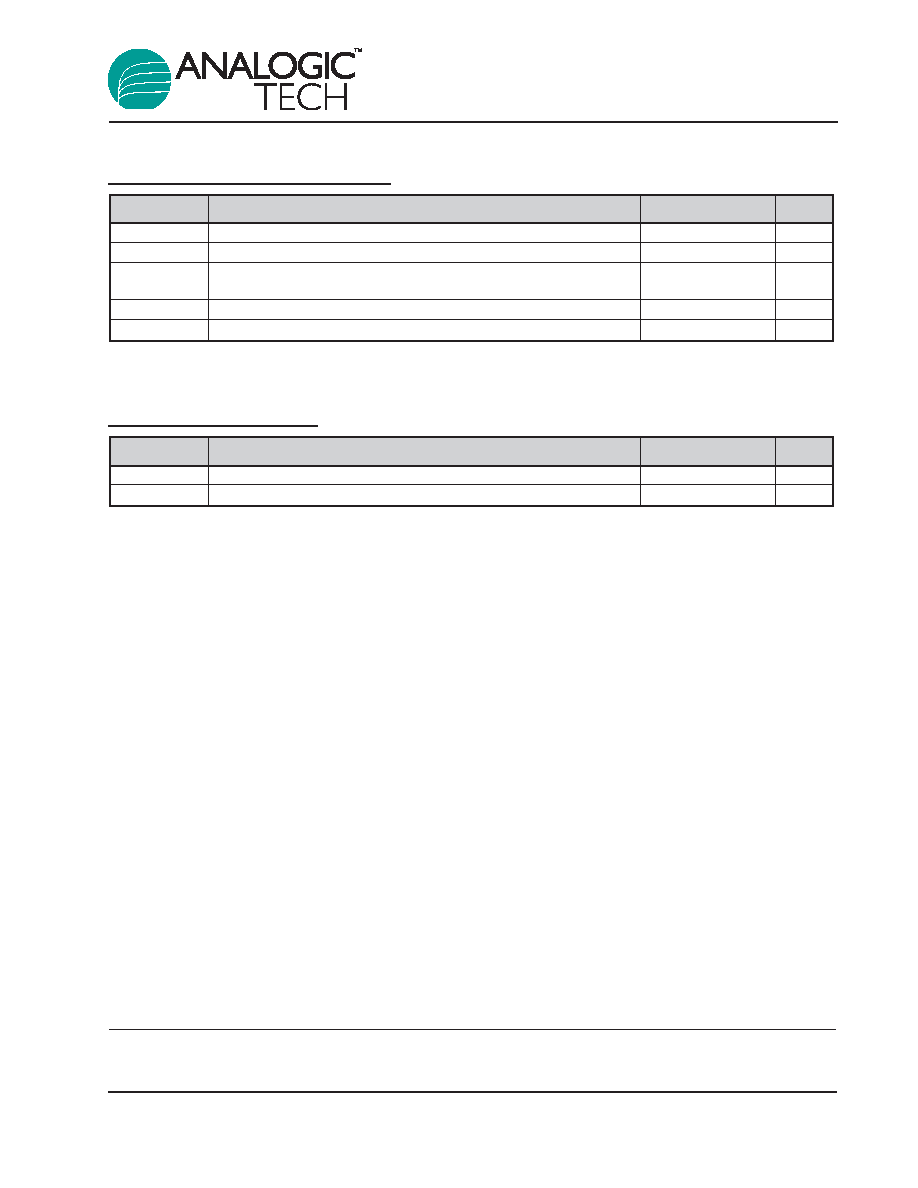
Absolute Maximum Ratings
1
Thermal Information
2
Symbol
Description
Value
Units
JA
Maximum Thermal Resistance
37
∞C/W
P
D
Maximum Power Dissipation
2.7
W
Symbol
Description
Value
Units
V
P
USB, ADP Input Voltage, <30ms, Duty Cycle <10%
-0.3 to 7.0
V
V
P
USB, ADP Input Voltage, Continuous
-0.3 to 6.0
V
V
N
BAT, USBSEL, USBH, USBL, ADPSET, STAT1, STAT2, ADPP#,
-0.3 to V
VP
+ 0.3
V
DATA, TS, CT, CHR, EN
T
J
Operating Junction Temperature Range
-40 to 150
∞C
T
LEAD
Maximum Soldering Temperature (at leads)
300
∞C
AAT3686
USB Port/AC Adapter
Lithium-Ion/Polymer Battery Charger
3686.2006.04.1.4
3
1. Stresses above those listed in Absolute Maximum Ratings may cause permanent damage to the device. Functional operation at condi-
tions other than the operating conditions specified is not implied. Only one Absolute Maximum Rating should be applied at any one time.
2. Mounted on an FR4 board.
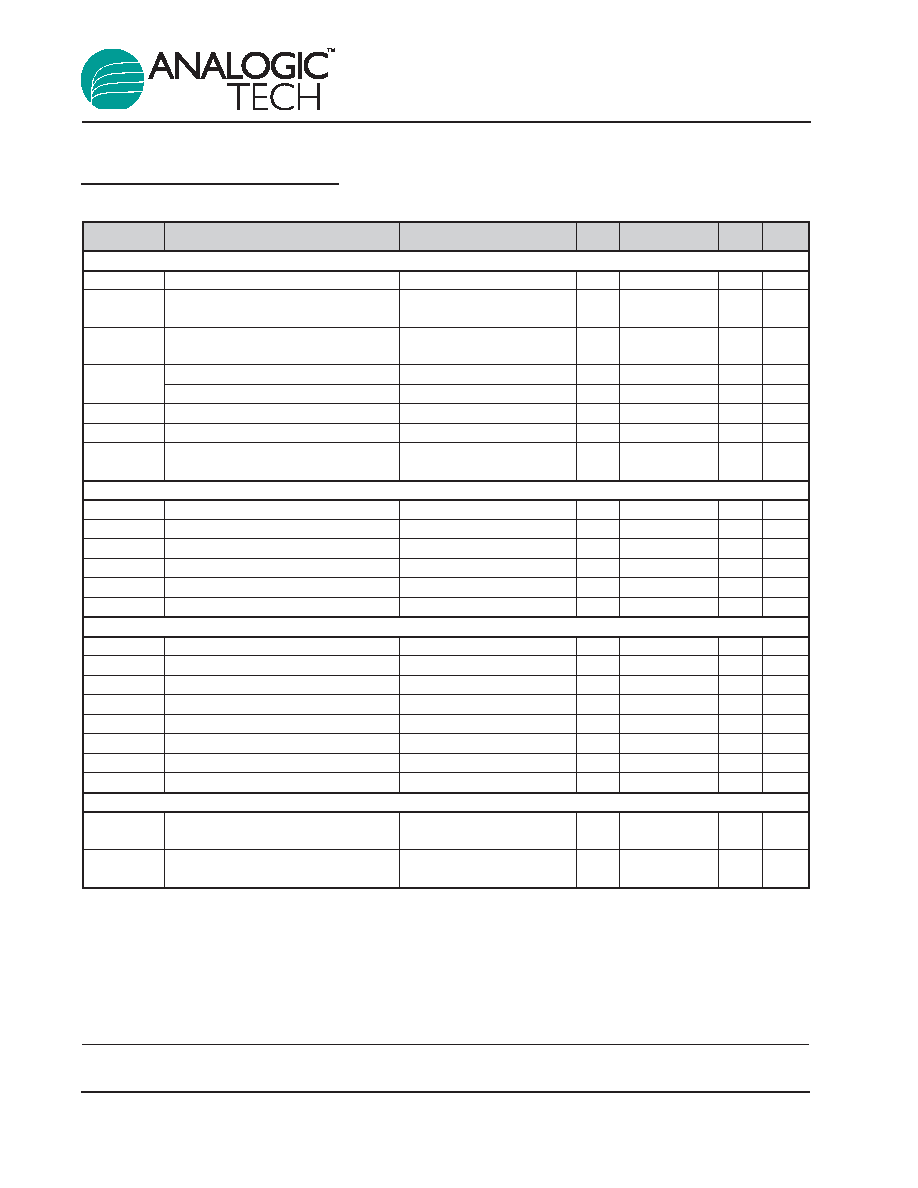
Electrical Characteristics
1
V
ADP
= 5V, T
A
= -25∞C to +85∞C, unless otherwise noted. Typical values are at T
A
= 25∞C.
Symbol
Description
Conditions
Min
Typ
Max Units
Operation
USB, ADP USB Port or Adapter Voltage Range
4.0
5.5
V
V
ADPP
Adapter Present Indicator
USB Present
4.25
4.5
4.7
V
Threshold Voltage
V
U_DSBL
ADP Voltage Level to Disable
4.25
4.5
4.7
V
USB Charging
V
UVLO
Under-Voltage Lockout
Rising Edge
3.0
V
Under-Voltage Lockout Hysteresis
150
mV
I
OP
Operating Current
CC Charge Current = 500mA
0.75
1.5
mA
I
SLEEP
Sleep Mode Current
V
BAT
= 4.25V
0.3
1.0
µA
I
Leakage
Reverse Leakage Current from
V
BAT
= 4V, USB,
1.0
µA
BAT Pin
ADP Pins Open
Voltage Regulation
V
BAT_EOC
1
End of Charge Voltage Accuracy
4.158
4.2
4.242
V
V
BAT
/V
BAT
EOC Voltage Tolerance
0.5
%
V
MIN
Preconditioning Voltage Threshold
2.8
3.0
3.15
V
V
RCH
Battery Recharge Voltage Threshold
V
BAT_EOC
- 0.1
V
V
USB_CHR
USB Charge Reduction Regulation
No Connection on CHR Pin
4.3
4.5
4.64
V
V
CHR
CHR Pin Voltage Accuracy
1.9
2.0
2.1
V
Current Regulation
I
CH
Charge Current
100
1500
mA
I
CH
/I
CH
Charge Current Regulation Tolerance
10
%
V
ADPSET
ADPSET Pin Voltage
CC Mode
2.0
V
V
USBH
USBH Pin Voltage
CC Mode
2.0
V
V
USBL
USBL Pin Voltage
CC Mode
2.0
V
K
IA
Current Set Factor: I
CHARGE
/I
ADPSET
4000
K
IUH
Current Set Factor: I
CHARGE
/I
USBH
2000
K
IUL
Current Set Factor: I
CHARGE
/I
USBL
2000
Charging Devices
R
DS(ON)A
Adapter Charging Transistor
V
IN
= 5.5V
0.2
0.25
0.35
On Resistance
R
DS(ON)U
USB Charging Transistor
V
IN
= 5.5V
0.4
0.5
0.65
On Resistance
AAT3686
USB Port/AC Adapter
Lithium-Ion/Polymer Battery Charger
4
3686.2006.04.1.4
1. The AAT3686 output charge voltage is specified over the 0∞ to 70∞C ambient temperature range; operation over the -25∞C to +85∞C
temperature range is guaranteed by design.

Electrical Characteristics
1
V
ADP
= 5V, T
A
= -25∞C to +85∞C, unless otherwise noted. Typical values are at T
A
= 25∞C.
Symbol
Description
Conditions
Min Typ
Max Units
Logic Control / Protection
V
USBSEL(H)
Input High Threshold
1.6
V
V
USBSEL(L)
Input Low Threshold
0.4
V
V
EN(H)
Input High Threshold
1.6
V
V
EN(L)
Input Low Threshold
0.4
V
V
ADPP#
Output Low Voltage
ADPP# Pin Sinks 4mA
0.4
V
T
P
Preconditioning Time Out (ADP mode only)
C
CT
= 100nF, V_ADP = 5.5V
25
Minute
T
C
Preconditioning and Constant Current Mode
C
CT
= 100nF, V_ADP = 5.5V
3.0
Hour
Time Out (ADP mode only)
T
V
Constant Voltage Mode Time Out
C
CT
= 100nF, V_ADP = 5.5V
3.0
Hour
(ADP mode only)
V
STAT
Output Low Voltage
STAT Pin Sinks 4mA
0.4
V
I
STAT
STAT Pin Current Sink Capability
8.0
mA
V
OVP
Over-Voltage Protection Threshold
4.4
V
Pre-Charge Current I
TK
/I
CHG
For Adapter or USBH Mode
10
%
For USBL Mode
50
Charge Termination Threshold Current
For Adapter or USBH Mode
7.5
%
I
TERM
/I
CHG
Charge Termination Threshold Current
For USBL Mode
35
%
I
TERM
/I
CHG
I
TS
Current Source from TS Pin
70
80
90
µA
TS1
TS Hot Temperature Fault
Threshold 310
330
350
mV
Hysteresis
15
TS2
TS Cold Temperature Fault
Threshold 2.2
2.3
2.4
V
Hysteresis
10
mV
I_DATA
DATA Pin Sink Current
DATA Pin is Active Low State
3
mA
I_ADPP#
ADPP# Current Sink Capability
ADPP# Pin is Active Low State
8
mA
V
DATA(H)
Input High Threshold
1.6
V
V
DATA)(L)
Input Low Threshold
0.4
V
SQ
PULSE
Status Request Pulse Width
Status Request
200
ns
t
PERIOD
System Clock Period
50
µs
f
DATA
Data Output Frequency
20
kHz
T
REG
Thermal Loop Regulation
90
∞C
T
LOOP_IN
Thermal Loop Entering Threshold
110
∞C
T
LOOP_OUT
Thermal Loop Exiting Threshold
85
∞C
T
OVSD
Over-Temperature Shutdown Threshold
145
∞C
AAT3686
USB Port/AC Adapter
Lithium-Ion/Polymer Battery Charger
3686.2006.04.1.4
5
1. The AAT3686 output charge voltage is specified over the 0∞ to 70∞C ambient temperature range; operation over the -25∞C to +85∞C
temperature range is guaranteed by design.

Typical Characteristics
Preconditioning Charge Current vs. Temperature
(ADPSET = 8.06k
; USBH = 8.06k)
Temperature (
∞C)
I
CH
ADP (mA)
I
CH
USB (mA)
USBH
ADP
80
90
100
110
120
-50
-25
0
25
50
75
100
40
45
50
55
60
Preconditioning Threshold
Voltage vs. Temperature
Temperature (
∞C)
V
MIN
(V)
USBH
ADP
2.95
2.96
2.97
2.98
2.99
3.00
3.01
3.02
3.03
3.04
3.05
-50
-25
0
25
50
75
100
End of Charge Voltage vs. Temperature
Temperature (
∞C)
V
BAT
(V)
ADP
USBH
4.158
4.179
4.200
4.221
4.242
-50
-25
0
25
50
75
100
Recharge Voltage vs. Temperature
Temperature (
∞C)
V
RCH
(V)
4.040
4.050
4.060
4.070
4.080
4.090
4.100
4.110
4.120
4.130
4.140
-50
-25
0
25
50
75
100
USBH
ADP
Battery Voltage vs. Supply Voltage
Supply Voltage (V)
V
BAT
(V)
USBH
ADP
4.158
4.179
4.200
4.221
4.242
4.5
4.75
5.0
5.25
5.5
I
FASTCHARGE
vs. R
SET
R
SET
(k
)
I
FASTCHARGE
(mA)
10
100
1000
10000
1
10
100
USBL
USBH
ADP
AAT3686
USB Port/AC Adapter
Lithium-Ion/Polymer Battery Charger
6
3686.2006.04.1.4
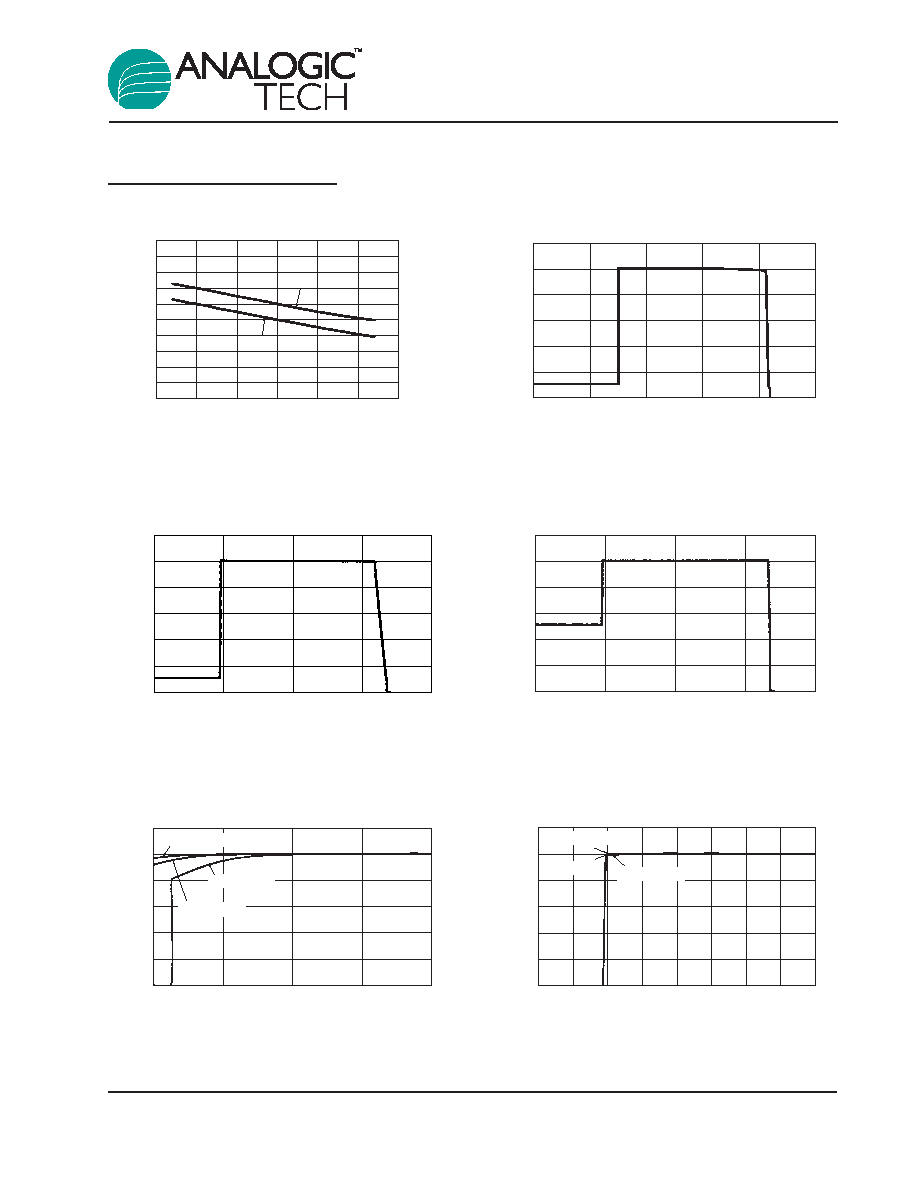
Typical Characteristics
Fast Charge Current vs. Supply Voltage
(USBH; USBH = 8.06k
)
Supply Voltage (V)
I
CH
(mA)
0
100
200
300
400
500
600
4.0
4.25
4.5
4.75
5.0
5.25
5.5
5.75
6.0
V
BAT
= 3.3V
V
BAT
= 3.5V
V
BAT
= 3.9V
Fast Charge Current vs. Supply Voltage
(Adapter; ADPSET = 8.06k
)
Supply Voltage (V)
I
CH
(mA)
0
200
400
600
800
1000
1200
4.0
4.5
5.0
5.5
6.0
V
BAT
= 3.3V
V
BAT
= 3.5V
V
BAT
= 3.9V
Charging Current vs. Battery Voltage
(USBL; USBL = 40.2k
)
Battery Voltage (V)
I
CH
(mA)
0
20
40
60
80
100
120
2.5
3.0
3.5
4.0
4.5
Charging Current vs. Battery Voltage
(USBH; USBH = 8.06k
)
Battery Voltage (V)
I
CH
(mA)
0
100
200
300
400
500
600
2.5
3.5
4.5
4.0
3.0
Charging Current vs. Battery Voltage
(Adapter; ADPSET = 8.06k
)
Battery Voltage (V)
I
CH
(A)
0.0
0.2
0.4
0.6
0.8
1.0
1.2
2.5
2.9
3.3
3.7
4.1
4.5
Fast Charge Current vs. Temperature
(ADPSET = 8.0k
; USBH = 8.06k)
Temperature (
∞C)
I
CH
ADP (mA)
I
CH
USB (mA)
900
920
940
960
980
1000
1020
1040
1060
1080
1100
-50
-25
0
25
50
75
100
440
450
460
470
480
490
500
510
520
530
540
ADP
USBH
AAT3686
USB Port/AC Adapter
Lithium-Ion/Polymer Battery Charger
3686.2006.04.1.4
7

Typical Characteristics
V
IL
vs. Supply Voltage
USBSEL (Falling)
Supply Voltage (V)
V
IH
(V)
0.4
0.5
0.6
0.7
0.8
0.9
1.0
1.1
1.2
1.3
1.4
4.2
4.4
4.6
4.8
5.0
5.2
5.4
5.6
5.8
6.0
-40∞C
+25∞C
+85∞C
V
IH
vs. Supply Voltage
USBSEL (Rising)
Supply Voltage (V)
V
IH
(V)
0.4
0.5
0.6
0.7
0.8
0.9
1.0
1.1
1.2
1.3
1.4
4.2
4.4
4.6
4.8
5.0
5.2
5.4
5.4
5.8
6.0
-40∞C
+25∞C
+85∞C
V
IL
vs. Supply Voltage
EN Pin (Falling)
Supply Voltage (V)
V
IH
(V)
0.4
0.5
0.6
0.7
0.8
0.9
1.0
1.1
1.2
1.3
1.4
4.2
4.4
4.6
4.8
5.0
5.2
5.4
5.6
5.8
6.0
-40∞C
+25∞C
+85∞C
V
IH
vs. Supply Voltage
EN Pin (Rising)
Supply Voltage (V)
V
IH
(V)
0.4
0.5
0.6
0.7
0.8
0.9
1.0
1.1
1.2
1.3
1.4
4.2
4.4
4.6
4.8
5.0
5.2
5.4
5.6
5.8
6.0
-40∞C
+25∞C
+85∞C
Fast Charge Current vs. Supply Voltage
(USBH; USBH = 8.06k
)
Supply Voltage (V)
I
CH
(mA)
0
100
200
300
400
500
600
4.4
4.5
4.6
4.7
4.8
4.9
5.0
0∞C
25∞C
70∞C
Fast Charge Current vs. Supply Voltage
(USBL; USBL = 40.2k
)
Supply Voltage (V)
I
CH
(mA)
0
20
40
60
80
100
120
4.0
5.0
6.0
4.5
5.5
6.5
V
BAT
= 3.3V
V
BAT
= 3.5V
V
BAT
= 3.9V
AAT3686
USB Port/AC Adapter
Lithium-Ion/Polymer Battery Charger
8
3686.2006.04.1.4

Typical Characteristics
Temperature Sense Output Current
vs. Temperature
Temperature (
∞
∞C)
TS Pin Current (
A)
72
74
76
78
80
82
84
86
88
-50
-25
0
25
50
75
100
CT Pin Capacitance vs. Counter Timeout
Time (hours)
Capacitance (
F)
0.0
0.2
0.4
0.6
0.8
1.0
1.2
1.4
1.6
1.8
2.0
0
6
4
2
8
10
Precondition Timeout
Constant Current Timeout
Counter Timeout vs. Temperature
(CT = 0.1µF)
Temperature (
∞
∞C)
Counter Timeout (%)
-10
-8
-6
-4
-2
0
2
4
6
8
10
-50
-25
0
25
50
75
100
USB Charge Current vs. Time
(USBH; USBH = 8.06k
)
Time (sec)
USB V
BUS
(200mV/div)
USB Charge
Current
(200mA/div)
USB Peripheral
Current
Consumption
(200mA/div)
0
2
4
6
8
10
Charge Reduction
Mode Activated
Adapter Mode Supply Current
vs. ADPSET Resistor
ADPSET Resistor (k
)
I
Q
(mA)
0.00
0.10
0.20
0.30
0.40
0.50
0.60
0.70
0.80
1
10
100
1000
Constant Current
Pre-Conditioning
AAT3686
USB Port/AC Adapter
Lithium-Ion/Polymer Battery Charger
3686.2006.04.1.4
9
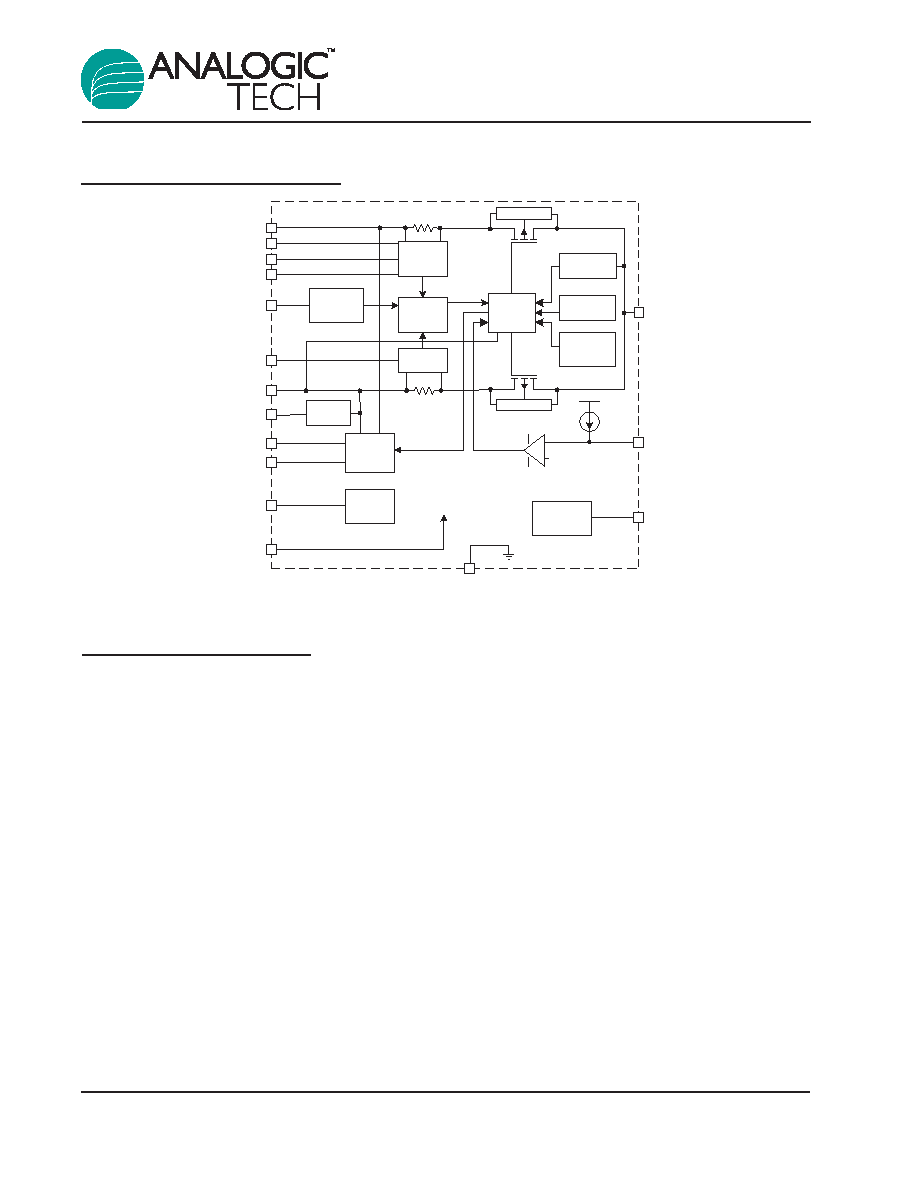
Functional Block Diagram
Charge
Control
Current
Compare
Reverse Blocking
Reverse Blocking
CV/
Precharge
USB
USBSEL
Constant
Current
Current
Compare
ADP
BAT
ADPSET
UVLO
Over-
Temperature
Protect
Charge
Status
STAT2
STAT1
TS
Window
Comparator
80µA
USBH
USBL
Serial
Data
DATA
Watchdog
Timer
CT
GND
Charge
Reduction
Loop
CHR
Voltage
Sense
ADPP#
EN
IC enable
AAT3686
USB Port/AC Adapter
Lithium-Ion/Polymer Battery Charger
10
3686.2006.04.1.4
Functional Description
The AAT3686 is a highly integrated single-cell lithium-
ion/polymer battery charger IC designed to operate
with USB port and AC adapter inputs, while requiring
a minimum number of external components. The
AAT3686 precisely regulates battery charge voltage
and current for 4.2V lithium-ion/polymer battery cells.
The adapter charge input constant current level can
be programmed up to 1.5A for rapid charging appli-
cations. In the absence of a high current adapter
input source, the AAT3686 can be powered from a
USB port V
BUS
supply. Depending on the USB port
type, the AAT3686 constant charge current can be
externally programmed for two levels, USB high and
USB low, for maximum constant current charge lev-
els up to 500mA. Typically, the USB charge levels
are set at 500mA and 100mA for the USBH and
USBL modes; however, the user may program
either mode to any level up to 500mA.
The USBH/L mode has automatic Charge Reduction
Loop control to allow users to charge the battery with
limited available current from a USB port, while
maintaining the regulated port voltage. This system
assures the battery charge function will not overload
a USB port while charging if other system demands
also share power with the respective port supply.
The USB charge function is automatically disabled
when an adapter input power source greater than
4.4V is present.
Status monitor output pins are provided to indicate
the battery charge status by directly driving two
external LEDs. A serial interface output is available
to report 22 various status states to a microcontroller.
Battery temperature and charge state are fully mon-
itored for fault conditions. In the event of an over-
voltage or over-temperature failure, the device will
automatically shut down, thus protecting the charg-
ing device, control system, and the battery under
charge. In addition to internal charge controller ther-
mal protection, the AAT3686 also provides a tem-
perature sense feedback function (TS pin) from the
battery to shut down the device in the event the bat-
tery exceeds its own thermal limit during charging.
All fault events are reported to the user either by the
simple status LEDs or via the DATA pin function.
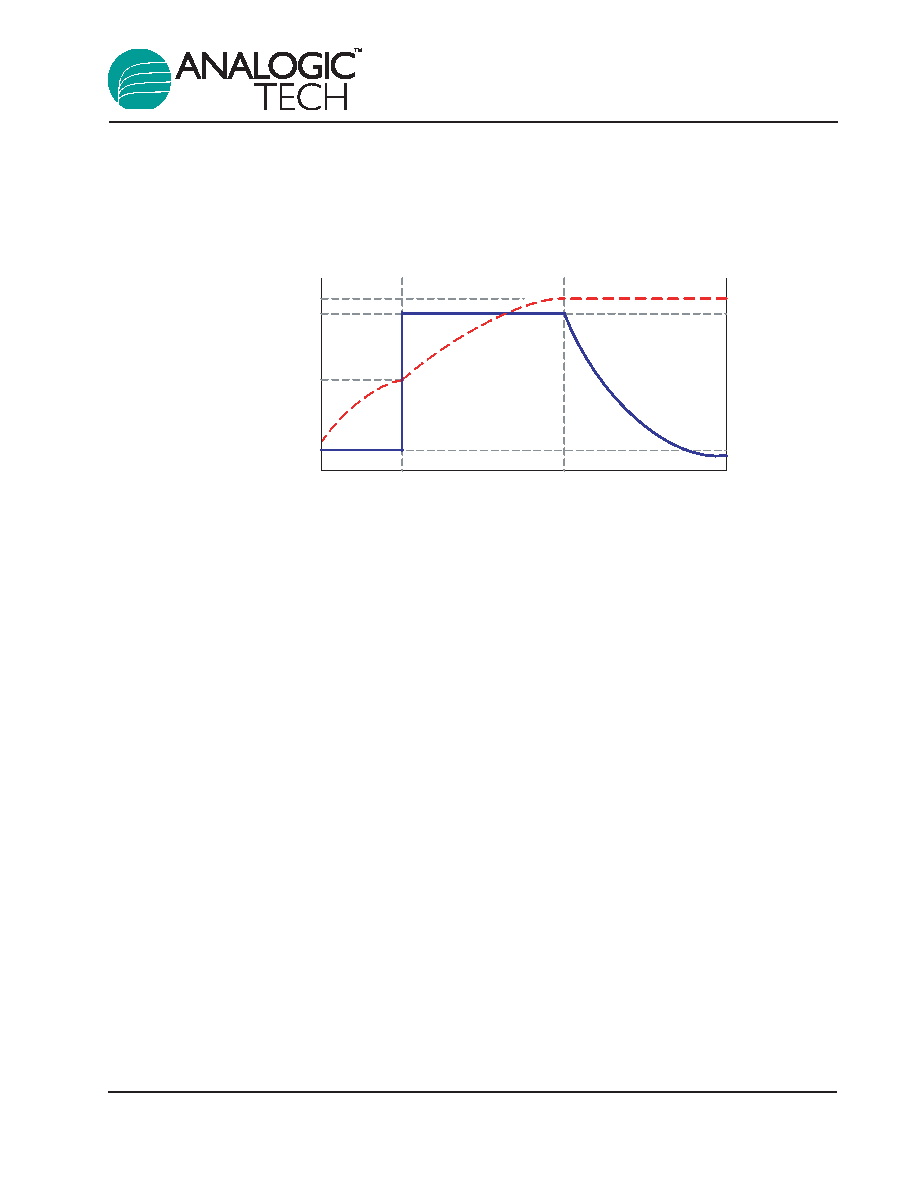
AAT3686
USB Port/AC Adapter
Lithium-Ion/Polymer Battery Charger
3686.2006.04.1.4
11
Charging Operation
Regardless of which charge input function is selected (i.e., either the adapter input or USB input), the AAT3686
has four basic modes for the battery charge cycle: pre-conditioning/trickle charge; constant current/fast charge;
constant voltage; and end of charge (see Figure 1).
Figure 1: Current vs. Voltage Profile During Charging Phases.
Preconditioning
Trickle Charge
Phase
Constant Current
Charge Phase
Constant Voltage
Charge Phase
Charge Complete Voltage
Constant Current Mode
Voltage Threshold
Regulated Current
Trickle Charge and
Termination Threshold
I = CC / 10
I = Max CC
Battery Preconditioning
Before the start of charging, the AAT3686 checks
several conditions in order to assure a safe charging
environment. The input supply must be above the
minimum operating voltage, or under-voltage lock-
out threshold (V
UVLO
), for the charging sequence to
begin. Also, the cell temperature, as reported by a
thermistor connected to the TS pin from the battery,
must be within the proper window for safe charging.
When these conditions have been met and a battery
is connected to the BAT pin, the AAT3686 checks
the state of the battery. If the cell voltage is below the
preconditioning voltage threshold (V
MIN
), the
AAT3686 begins preconditioning the cell.
The battery preconditioning trickle charge current is
equal to the fast charge constant current divided by
10 (USBL divided by 2). For example, if the pro-
grammed fast charge current is 500mA, then the
preconditioning mode (trickle charge) current will be
50mA. Cell preconditioning is a safety precaution for
a deeply discharged battery and also aids in limiting
power dissipation in the pass transistor when the
voltage across the device is at the greatest potential.
Fast Charge / Constant Current Charging
Cell preconditioning continues until the voltage on
the BAT pin exceeds the preconditioning voltage
threshold (V
MIN
). At this point, the AAT3686 begins
the constant current fast charging phase. The fast
charge constant current (I
CC
) amplitude is deter-
mined by the charge mode, ADP, USBH or USBL,
and is programmed by the user via the R
SET
, R
SETH
,
and R
SETL
resistors. The AAT3686 remains in con-
stant current charge mode until the battery reaches
the voltage regulation point, V
BAT
.
Constant Voltage Charging
The system transitions to a constant voltage charg-
ing mode when the battery voltage reaches the
output charge regulation threshold (V
BAT
) during
the constant current fast charge phase. The regu-
lation voltage level is factory programmed to 4.2V
(±1%). Charge current in the constant voltage
mode drops as the battery cell under charge reach-
es its maximum capacity.
End of Charge Cycle Termination and
Recharge Sequence
When the charge current drops to 7.5% (35% for
USBL) of the programmed fast charge current level
in the constant voltage mode, the device termi-
nates charging and goes into a standby state. The
charger will remain in a standby state until the bat-
tery voltage decreases to a level below the battery
recharge voltage threshold (V
RCH
).

AAT3686
USB Port/AC Adapter
Lithium-Ion/Polymer Battery Charger
12
3686.2006.04.1.4
System Operation Flow Chart
UVLO
Battery
Temp. Monitor
V
TS1
<TS<V
TS2
Preconditioning Test
Current Phase Test
V
CH
> V
BAT
V
MIN
> V
BAT
Voltage Phase Test
V
P
> V
UVLO
Shut Down
Mode
Shutdown
Mode
No
No
Yes
Yes
Low Current
Conditioning
Charge
Low Current
Conditioning
Charge
Battery
Temp. Fault
Battery
Temp. Fault
No
No
Current
Charging
Mode
Current
Charging
Mode
Yes
Voltage
Charging
Mode
Voltage
Charging
Mode
I
BAT
> I
MIN
No
Yes
No
Switch
On
Switch
On
Yes
Yes
USB Detect
USBSEL > 0
USB
Charge
Completed
Charge
Completed
Recharge Test
V
RCH
> V
BAT
ADP
Yes
No
Charge
Safety
Timer
Charge
Safety
Timer
Set
Expire
Power On
Reset
Power On
Reset
Sleep
Mode
Sleep
Mode
Power Select
Output
ADPP
Output
ADPP
Yes
USB High
Current Loop
USB High
Current Loop
USB Low
Current Loop
USB Low
Current Loop
No
Yes
No
Device Temp. Monitor
T
J
> 110
∞C
Yes
Fault
Conditions Monitor
OV, OT
Yes
Thermal Loop
Current
Reduction in ADP
Charging Mode
Thermal Loop
Current
Reduction in ADP
Charging Mode
USB Voltage Test
V
USB
< 4.5V
No
Thermal Loop
Enable
Thermal
Loop Enable
USB Voltage
Regulation
Enable
USB Voltage
Regulation
Enable
USB Loop
Current
Reduction in USB
Charging Mode
USB Loop
Current
Reduction in USB
Charging Mode
Timing
ADP
Loop
ADP
Loop
ADP
Voltage
Test
ADP > V
ADPP
No
Yes
No
Enable
When the input supply is disconnected or drops
below UVLO or EN = 0, the charger will automati-
cally enter power-saving sleep mode. Consuming
an ultra-low 0.3µA in sleep mode, the AAT3686
minimizes battery drain when it is not charging.
This feature is particularly useful in applications
where the input supply level may fall below the bat-
tery charge or under-voltage lockout level. In such
cases where the AAT3686 input voltage drops, the
device will enter sleep mode and automatically
resume charging once the input supply has recov-
ered from its fault condition.
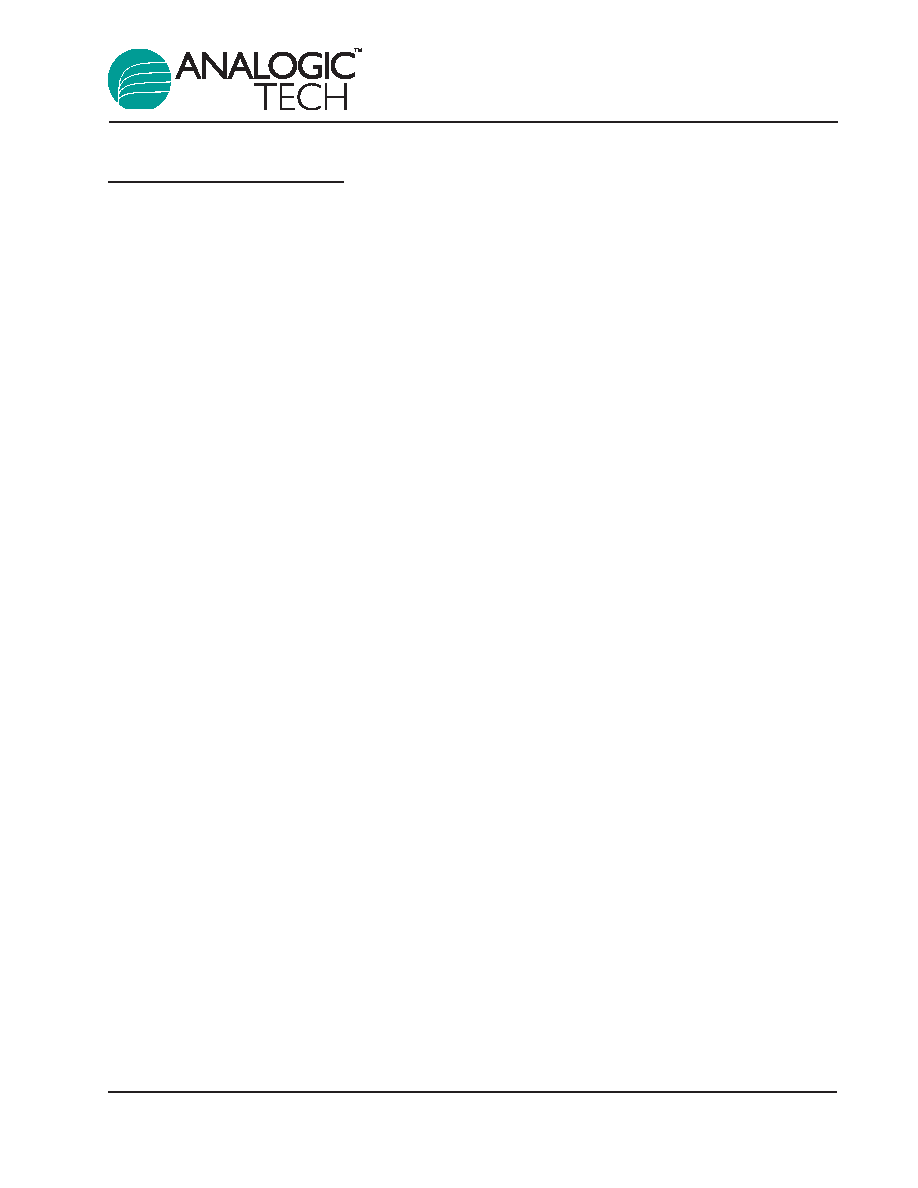
AAT3686
USB Port/AC Adapter
Lithium-Ion/Polymer Battery Charger
3686.2006.04.1.4
13
Application Information
AC Adapter / USB System Power Charging
Adapter Mode
In the adapter mode, constant current charge lev-
els up to 1.5A can be programmed by the user. The
AAT3686 system control will always select the
adapter input over the USB supply input whenever
adapter voltage is present on the ADP pin. The
AAT3686 will operate from the adapter input over a
4.0V to 5.5V range.
The constant current fast charge current for the
adapter input mode is set by the R
SET
resistor con-
nected between the ADPSET and ground. Refer to
Table 1 for recommended R
SET
values for a desired
constant current charge level. The presence of volt-
age on the adapter input is indicated by the ADPP#
pin function. This indicator pin is an open drain and
will pull the ADPP# pin low when voltage is detect-
ed on the ADP pin. The precise charging function in
the adapter mode may be read from the DATA pin
and/or status LEDs. Please refer to the Battery
Charge Status Indication discussion in this
datasheet for further details on data reporting.
Thermal Loop Control
Due to the integrated nature of the linear charging
control pass device for the adapter mode, a special
thermal loop control system has been employed to
maximize charging current under all operation condi-
tions. The thermal management system measures
the internal circuit die temperature and reduces the
fast charge current when the device exceeds a pre-
set internal temperature control threshold. Once the
thermal loop control becomes active, the fast charge
current is initially reduced by a factor of 0.44.
The initial thermal loop current can be estimated by
the following equation:
The thermal loop control re-evaluates the circuit die
temperature every three seconds and adjusts the
fast charge current back up in small steps to the full
fast charge current level or until an equilibrium cur-
rent is discovered and maximized for the given
ambient temperature condition. The thermal loop
controls the system charge level; therefore, the
AAT3686 will always provide the highest level of
constant current in the fast charge mode possible
for any given ambient temperature condition.
Adapter Input Charge Inhibit and Resume
The AAT3686 has an under-voltage lockout and
power on reset feature so that the charger will sus-
pend charging and shut down if the input supply to
the adapter pin drops below the UVLO threshold.
When power is re-applied to the adapter pin or the
UVLO condition recovers and ADP > V
BAT
, the sys-
tem charge control will assess the state of charge
on the battery cell and will automatically resume
charging in the appropriate mode for the condition
of the battery.
USB Mode
The AAT3686 provides an input for intelligent USB
charging. When no voltage is present on the
adapter input pin, the charge controller will automat-
ically switch to accepting power from the USB input.
The USB charge mode provides two programmable
fast charge levels up to 500mA each, USB high and
USB low, USBH and USBL, respectively. The USBH
or USBL modes may be externally selected by the
USB select pin (USBSEL). USBSEL is internally
pulled low through a 1M
resistor. When the USB-
SEL pin is connected to a logic high level, the USBH
level will be active. Conversely, when USBSEL is
pulled to a logic low level (ground), the USBL level
will be used for charging. Typically, USBH is set for
500mA and USBL is set for 100mA. However, these
two USB charge levels may be user programmed to
any level between 50mA and 500mA by selecting
the appropriate resistor values for R
SETH
and R
SETL
.
Refer to Table 1 for recommended R
SETH
and R
SETL
values for the desired USB input constant current
charge levels.
USB Charge Reduction
In many instances, product system designers do not
know the real properties of a potential USB port used
to supply power to the battery charger. Typically,
powered USB ports found on desktop and notebook
PCs should supply up to 500mA. In the event a USB
port being used to supply the charger is unable to
provide the programmed fast charge current or if the
system under charge must also share supply current
with other functions, the AAT3686 will automatically
reduce USB fast charge current to maintain port
integrity and protect the host system.
I
TLOOP
= I
CC
∑ 0.44
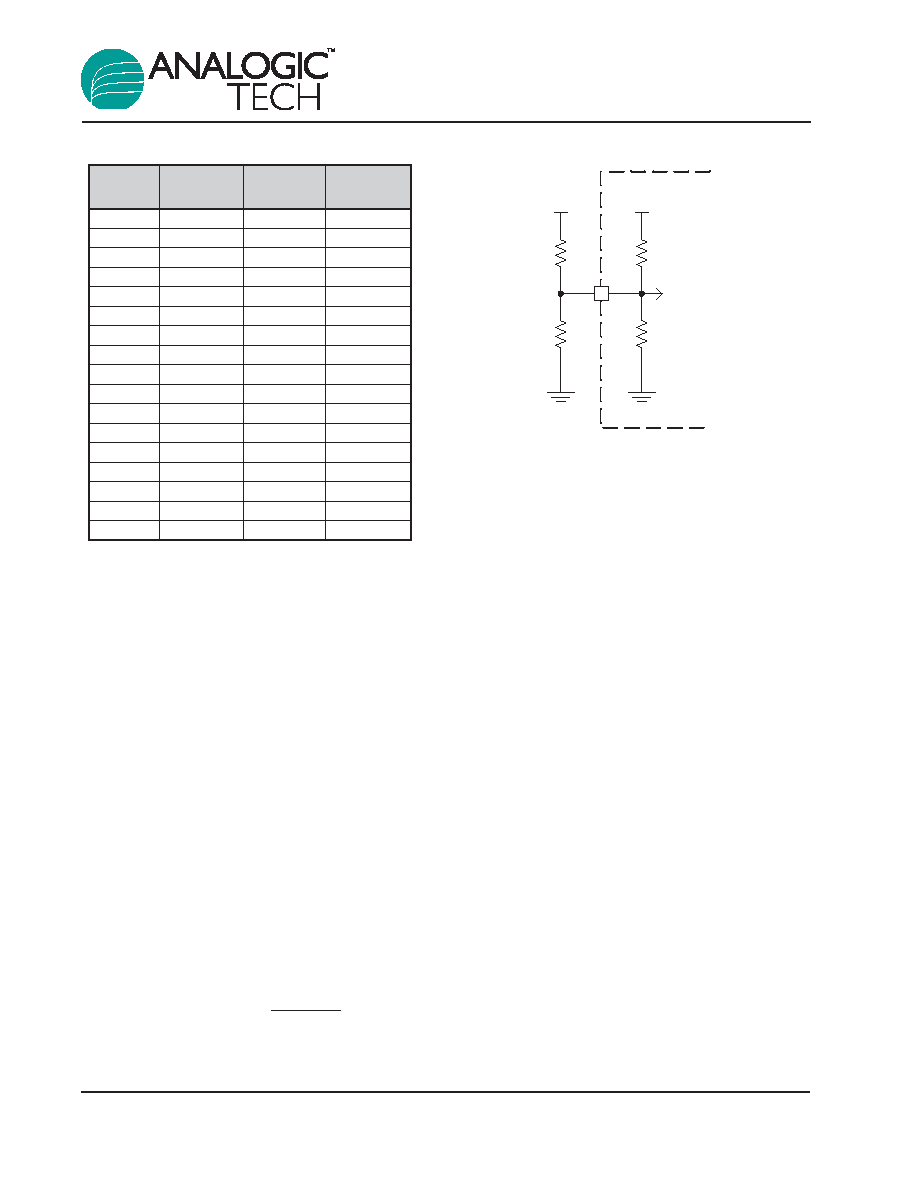
AAT3686
USB Port/AC Adapter
Lithium-Ion/Polymer Battery Charger
14
3686.2006.04.1.4
The USB charge reduction system becomes active
when the voltage on the USB input falls below the
USB charge reduction threshold (V
USBCHR
), which
is typically 4.5V. Regardless of which USB charge
function is selected (USBH or USBL), the charge
reduction system will reduce the fast charge cur-
rent level in a linear fashion until the voltage
sensed on the USB input recovers above the
charge reduction threshold voltage. The USB
charge reduction threshold (V
USBCHR
) can be exter-
nally set to a value lower than 4.5V by placing a
resistor divider network between V
USB
and ground
with the center connected to the CHR pin. The USB
charge reduction feature can be disabled by con-
necting a 10k
resistor from the CHR pin directly
to the USB input pin (see Figure 2).
The following equation can be used to approximate a
USB charge reduction threshold below 4.5V:
Where R11/R12 << 1M
.
USB Input Charge Inhibit and Resume
The AAT3686 UVLO and power on reset feature
will function when the USB input pin voltage level
drops below the UVLO threshold. At this point, the
charger will suspend charging and shut down.
When power is re-applied to the USB pin or the
UVLO condition recovers, the system charge con-
trol will assess the state of charge on the battery
cell and will automatically resume charging in the
appropriate mode for the condition of the battery.
Enable / Disable
The AAT3686 provides an enable function to con-
trol the charger IC on and off. The enable (EN) pin
is active high. When pulled to a logic low level, the
AAT3686 will be shut down and forced into the
sleep state. Charging will be halted regardless of
the battery voltage or charging state. When the
device is re-enabled, the charge control circuit will
automatically reset and resume charging functions
with the appropriate charging mode based on the
battery charge state and measured cell voltage.
V
USBCHR
= 2.0V ˜
R12
R12 + R11
Table 1: Resistor Values.
Figure 2: Internal Equivalent
Circuit for the CHR Pin.
1.025M
825k
R11
R12
V
CHR
= 2.0V
V
USB
USB
CHR
ADP
USBH
USBL
I
CC
R
SET
(k
) R
SET
(k
)
R
SET
(k
)
50
N/A
86.6
86.6
75
N/A
57.6
57.6
100
84.5
42.2
42.2
200
43.2
21.0
20.5
300
28.0
13.7
13.7
400
21.0
10.2
10.2
500
16.9
8.06
8.06
600
13.3
6.65
6.65
700
11.5
5.62
5.62
800
10.2
4.87
4.87
900
9.09
4.32
4.32
1000
8.06
3.83
3.83
1100
7.32
3.48
3.48
1200
6.65
3.16
3.16
1300
6.04
2.87
2.87
1400
5.62
2.67
2.67
1500
5.36
2.43
2.43
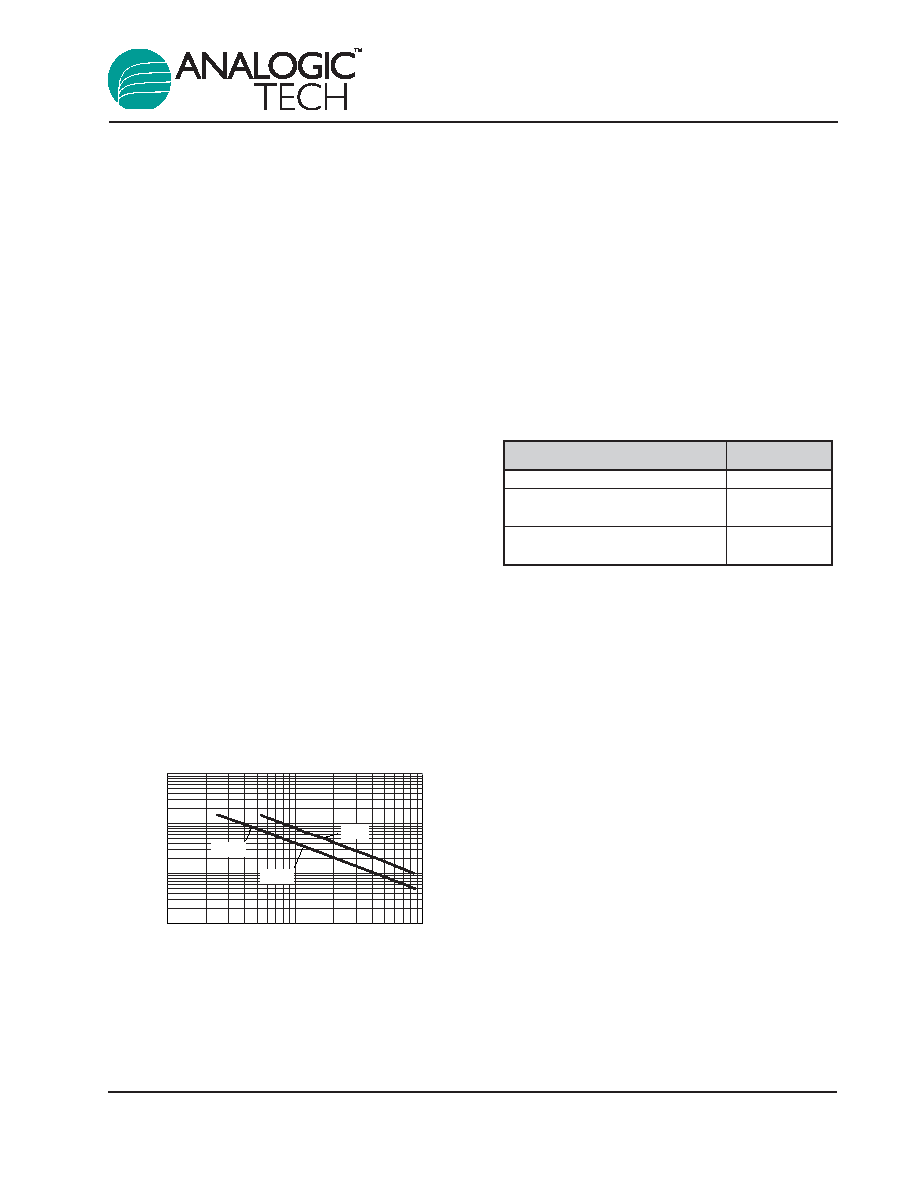
AAT3686
USB Port/AC Adapter
Lithium-Ion/Polymer Battery Charger
3686.2006.04.1.4
15
Programming Charge Current
The fast charge constant current charge level for
both adapter and USB input modes are pro-
grammed with set resistors placed between the
ADPSET, USBH, and USBL pins and ground. The
accuracy of the fast charge, as well as the precon-
ditioning trickle charge current, is dominated by the
tolerance of the set resistor used. For this reason,
1% tolerance metal film resistors are recommend-
ed for the set resistor function.
Fast charge constant current levels from 50mA to
1.5A can be set by selecting the appropriate resistor
value from Table 1. The R
SET
resistor should be con-
nected between the ADPSET pin and ground.
The USB input fast charge constant current charge
control provides for two current set levels, USBH
and USBL. The USBSEL pin is used to select the
high or low charge current levels in the USB charge
mode. When the USBSEL pin is pulled to a voltage
level above the V
USBSEL(H)
threshold, the USBH cur-
rent level will be selected. Conversely, this pin
should be pulled below V
USBSEL(L)
to enable the
USBL charge level. Typically, the two R
SETH
and
R
SETL
resistors for the USBH and USBL functions
are fixed for 500mA and 100mA USB fast charge
levels. However, these two charge levels can be set
to any level between 50mA and 500mA depending
upon the system design requirements for a given
USB charge application. Refer to Table 1 and
Figure 3 for recommended R
SETH
and R
SETL
values.
Figure 3: I
FASTCHARGE
vs. R
SET
.
Protection Circuitry
Programmable Watchdog Timer
The AAT3686 contains a watchdog timing circuit for
the adapter input charging mode. No watchdog tim-
ing functions are active for the USB input mode.
Typically, a 0.1µF ceramic capacitor is connected
between the TC pin and ground. When a 0.1µF
ceramic capacitor is used, the device will time a
shutdown condition if the trickle charge mode
exceeds 25 minutes and a combined trickle charge
plus fast charge mode of three hours. When the
device transitions to the constant voltage mode, the
timing counter is reset and will time out after three
hours and shut down the charger (see Table 2).
Table 2: Summary for a 0.1µF Used for the
Timing Capacitor.
The CT pin is driven by a constant current source
and will provide a linear response to increases in
the timing capacitor value. Thus, if the timing
capacitor were to be doubled from the nominal
0.1µF value, the time-out times would be doubled.
If the programmable watchdog timer function is not
needed, it can be disabled by connecting the CT
pin to ground. The CT pin should not be left float-
ing or un-terminated, as this will cause errors in the
internal timing control circuit.
The constant current provided to charge the timing
capacitor is very small, and this pin is susceptible
to noise and changes in capacitance value.
Therefore, the timing capacitor should be physical-
ly located on the printed circuit board layout as
closely as possible to the CT pin. Since the accu-
racy of the internal timer is dominated by the
capacitance value, 10% tolerance or better ceram-
ic capacitors are recommended. Ceramic capacitor
materials, such as X7R and X5R type, are a good
choice for this application.
Mode
Time
Trickle Charge (TC) Time Out
25 minutes
Trickle Charge (TC) +
3 hours
Fast Charge (CC) Time Out
Constant Voltage (VC) Mode
3 hours
Time Out
R
SET
(k
)
I
FASTCHARGE
(mA)
10
100
1000
10000
1
10
100
USBL
USBH
ADP
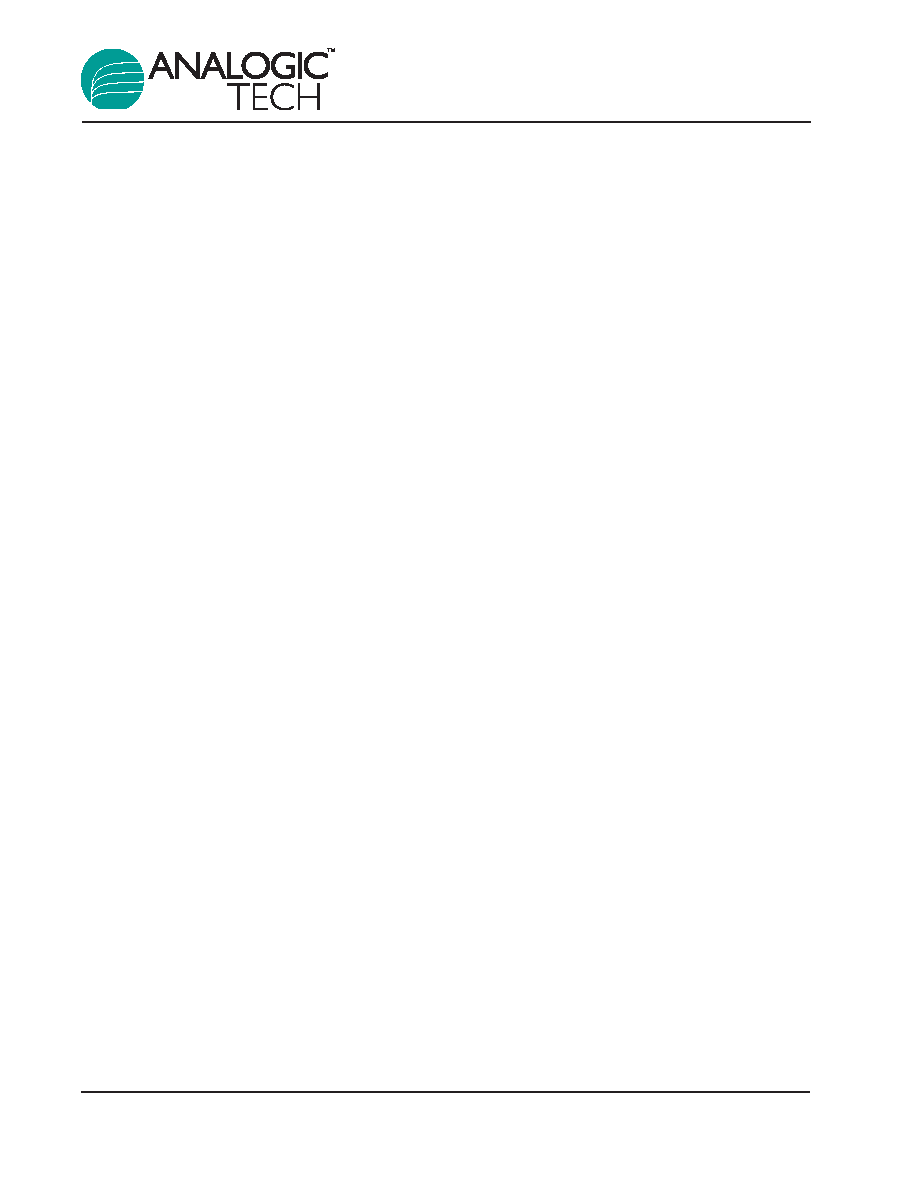
AAT3686
USB Port/AC Adapter
Lithium-Ion/Polymer Battery Charger
16
3686.2006.04.1.4
Over-Voltage Protection
An over-voltage event is defined as a condition
where the voltage on the BAT pin exceeds the max-
imum battery charge voltage and is set by the over-
voltage protection threshold (V
OVP
). If an over-volt-
age condition occurs, the AAT3686 charge control
will shut down the device until voltage on the BAT
pin drops below the over-voltage protection thresh-
old (V
OVP
). The AAT3686 will resume normal charg-
ing operation after the over-voltage condition is
removed. During an over-voltage event, the STAT
LEDs will report a system fault, and the actual fault
condition may be read via the DATA pin signal.
Over-Temperature Shutdown
The AAT3686 has a thermal protection control cir-
cuit which will shut down charging functions should
the internal die temperature exceed the preset
thermal limit threshold.
Battery Temperature Fault Monitoring
In the event of a battery over-temperature condi-
tion, the charge control will turn off the internal pass
device and report a battery temperature fault on the
DATA pin function. The STAT LEDs will also display
a system fault. After the system recovers from a
temperature fault, the device will resume charging
operation.
The AAT3686 checks battery temperature before
starting the charge cycle, as well as during all
stages of charging. This is accomplished by moni-
toring the voltage at the TS pin. This system is
intended to use negative temperature coefficient
thermistors (NTC), which are typically integrated
into the battery package. Most of the commonly
used NTC thermistors in battery packs are approx-
imately 10k
at room temperature (25∞C).
The TS pin has been specifically designed to
source 80µA of current to the thermistor. The volt-
age on the TS pin that results from the resistive
load should stay within a window from 335mV to
2.32V. If the battery becomes too hot during charg-
ing due to an internal fault, the thermistor will heat
up and reduce in value, pulling the TS pin voltage
lower than the TS1 threshold and the AAT3686 will
signal the fault condition.
If the use of the TS pin function is not required by
the system, it should be terminated to ground using
a 10k
resistor.
Battery Charge Status Indication
The AAT3686 indicates the status of the battery
under charge with two different systems. First, the
device has two status LED driver outputs. These
two LEDs can indicate simple functions such as no
battery charge activity, battery charging, charge
complete, and charge fault. The AAT3686 also pro-
vides a bi-directional data reporting function so that
a system microcontroller can interrogate the DATA
pin and read any one of 22 system states.
Status Indicator Display
Simple system charging status states can be dis-
played using one or two LEDs in conjunction with the
STAT1 and STAT2 pins on the AAT3686. These two
pins are simple switches to connect the LED cath-
odes to ground. It is not necessary to use both dis-
play LEDs if a user simply wants to have a single
lamp to show "charging" or "not charging." This can
be accomplished by using the STAT1 pin and a sin-
gle LED. Using two LEDs and both STAT pins simply
gives the user more information to the charging
states. Refer to Table 3 for LED display definitions.
The LED anodes should be connected to either
V
USB
or V
ADP
, depending upon system design
requirements. The LEDs should be biased with as
little current as necessary to create reasonable illu-
mination; therefore, a ballast resistor should be
placed between the LED cathodes and the
STAT1/2 pins. LED current consumption will add to
the overall thermal power budget for the device
package, so it is wise to keep the LED drive current
to a minimum. 2mA should be sufficient to drive
most low-cost green or red LEDs. It is not recom-
mended to exceed 8mA for driving an individual
status LED.

AAT3686
USB Port/AC Adapter
Lithium-Ion/Polymer Battery Charger
3686.2006.04.1.4
17
The required ballast resistor value can be estimat-
ed using the following formulas:
For connection to the adapter supply:
Example:
Note: Red LED forward voltage (V
F
) is typically
2.0V @ 2mA.
For connection to the USB supply:
Example:
Note: Green LED forward voltage (V
F
) is typically
3.2V @ 2mA.
The four status LED display conditions are
described in Table 3.
Digital Charge Status Reporting
The AAT3686 has a comprehensive digital data
reporting system by use of the DATA pin feature.
This function can provide detailed information
regarding the status of the charging system. The
DATA pin is a bi-directional port which will read back
a series of data pulses when the system microcon-
troller asserts a request pulse. This single strobe
request protocol will invoke one of 22 possible return
pulse counts which the microcontroller can look up
based on the serial report table shown in Table 4.
The DATA pin function is active low and should nor-
mally be pulled high to V
ADP
or V
USB
. This data line
may also be pulled high to the same level as the
high state for the logic I/O port on the system
microcontroller. In order for the DATA pin control
circuit to generate clean, sharp edges for the data
output and to maintain the integrity of the data tim-
ing for the system, the pull-up resistor on the data
line should be low enough in value so that the
DATA signal returns to the high state without delay.
If too small a pull-up resistor is used, the strobe
pulse from the system microcontroller could
exceed the maximum pulse time and the DATA out-
put control could issue false status reports. A 1.5k
resistor is recommended when pulling the DATA
pin high to 5.0V on either V
ADP
or V
USB
inputs. If the
data line is pulled high to a voltage level less than
5.0V, the pull-up resistor can be calculated based
on a recommended minimum pull-up current of
3mA. Use the following formula:
R
PULL-UP
V
PULL-UP
3mA
R
B(STAT2)
=
= 900
5.0V - 3.2V
2mA
R
B(STAT1/2)
= V
USB
- V
F(LED)
I
LED(STAT1/2)
R
B(STAT1)
=
= 1.75k
5.5V - 2.0V
2mA
R
B(STAT1/2)
= V
ADP
- V
F(LED)
I
LED(STAT1/2)
Table 3: Status LED Display Conditions.
Event Description
STAT1
STAT2
Charge Disabled or Low Supply
Off
Off
Charge Enabled Without Battery
Flash
1
Flash
1
Battery Charging
On
Off
Charge Completed
Off
On
Fault
On
On
1. Flashing rate depends on output capacitance.
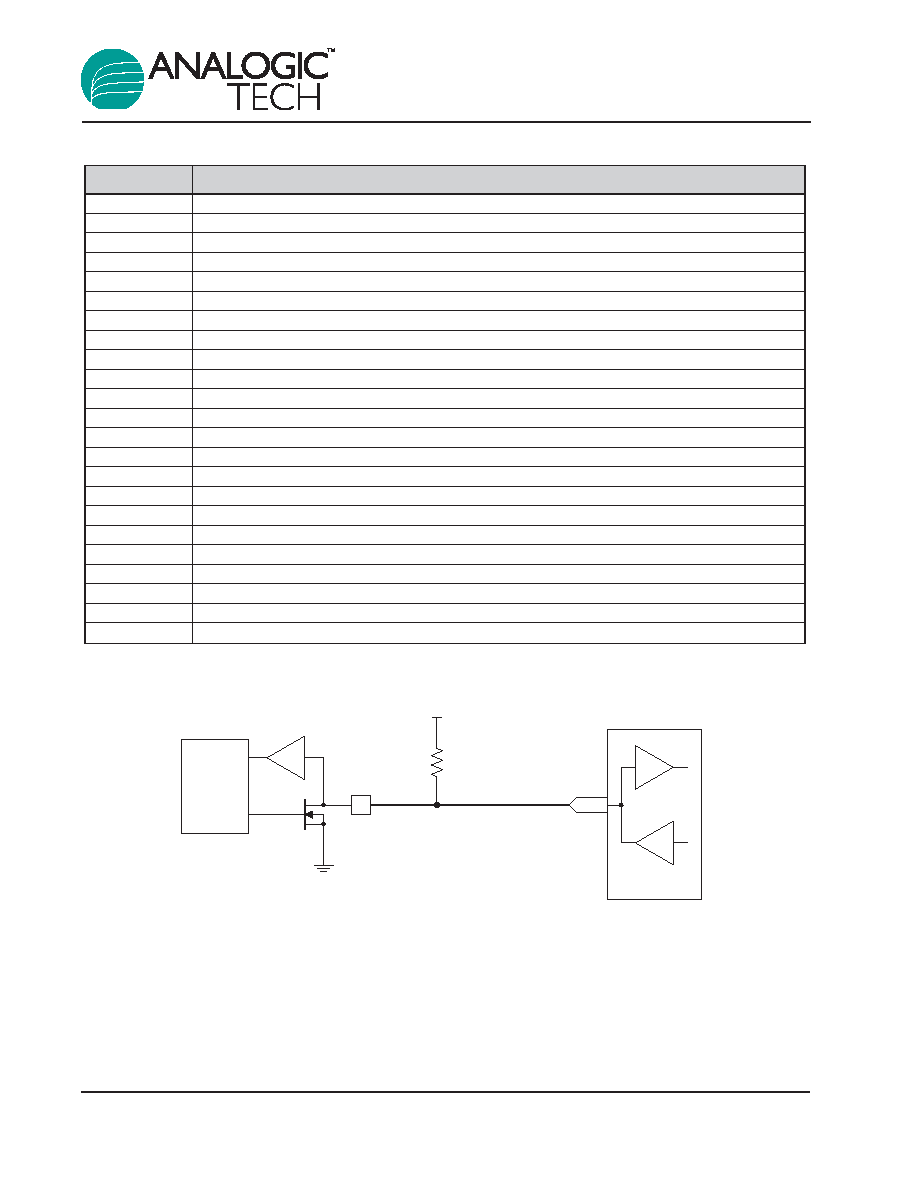
AAT3686
USB Port/AC Adapter
Lithium-Ion/Polymer Battery Charger
18
3686.2006.04.1.4
Data Timing
The system microcontroller should assert an active
low data request pulse for minimum duration of
200ns; this is specified by the SQ
PULSE
. Upon sens-
ing the rising edge of the end of the data request
pulse, the AAT3686 status data control will reply
the data word back to the system microcontroller
after a delay defined by the data report time speci-
fication T
DATA(RPT)
. The period of the following group
of data pulses will be defined by the T
DATA
specifi-
cation.
Table 4: Serial Data Report Table.
Figure 4: Data Pin Application Circuit.
IN
OUT
AAT3686
Status
Control
DATA Pin
P GPIO
Port
OUT
IN
GPIO
R
PULL_UP
1.8V to 5.0V
Number
DATA Report Status
1
Chip Over-Temperature Shutdown
2
Battery Temperature Fault
3
Over-Voltage Turn Off
4
Not Used
5
ADP Watchdog Time-Out in Battery Condition Mode
6
ADP Battery Condition Mode
7
ADP Watchdog Time-Out in Constant Current Mode
8
ADP Thermal Loop Regulation in Constant Current Mode
9
ADP Constant Current Mode
10
ADP Watchdog Time-Out in Constant Voltage Mode
11
ADP Constant Voltage Mode
12
ADP End of Charging
13
USBH Battery Condition Mode
14
USBH Charge Reduction in Constant Current Mode
15
USBH Constant Current Mode
16
USBH Constant Voltage Mode
17
USBH End of Charging
18
USBL Battery Condition Mode
19
USBL Charge End of Charging Reduction in Constant Current Mode
20
USBL Constant Current Mode
21
USBL Constant Voltage Mode
22
USBL End of Charging
23
Data Report Error
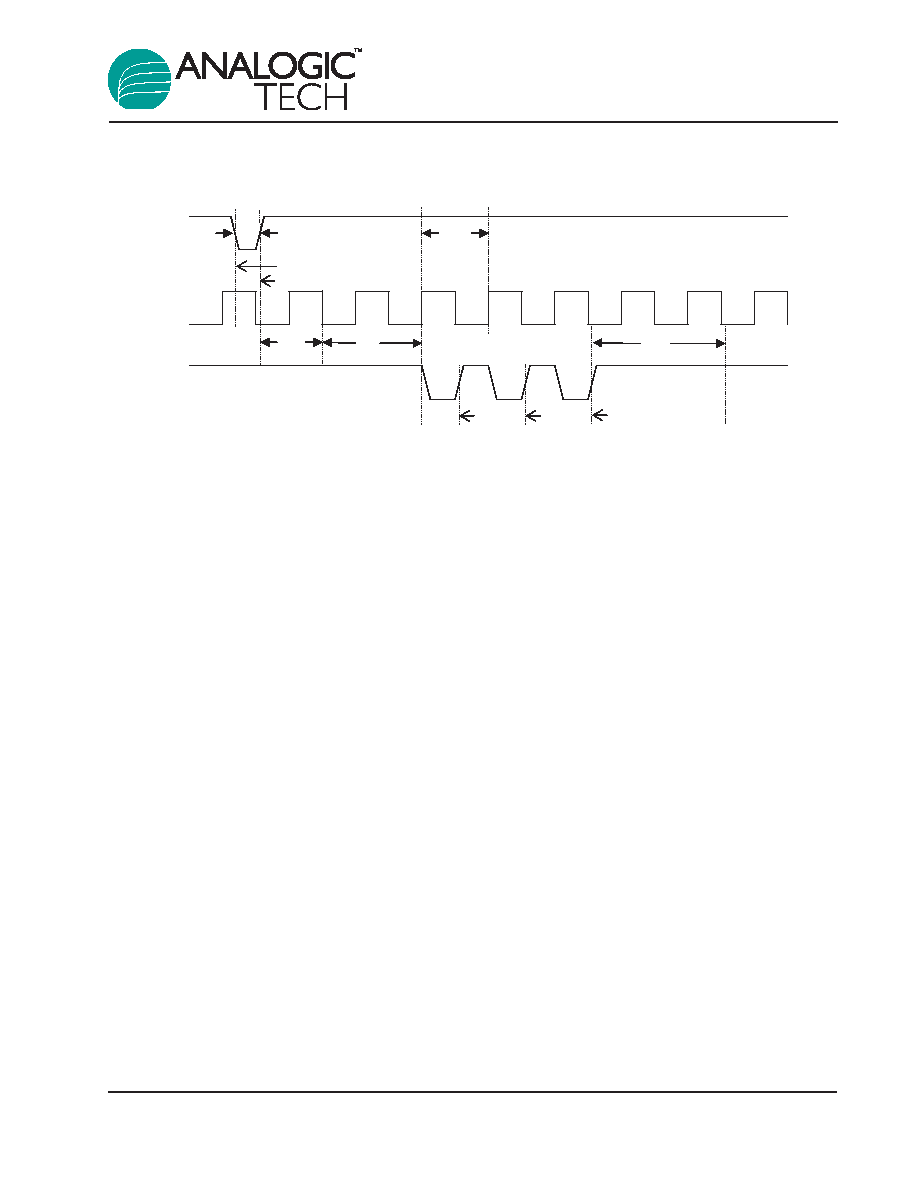
AAT3686
USB Port/AC Adapter
Lithium-Ion/Polymer Battery Charger
3686.2006.04.1.4
19
Thermal Considerations
The AAT3686 is offered in a 4x4mm TDFN pack-
age which can provide up to 2.7W of power dissi-
pation when it is properly bonded to a printed cir-
cuit board and has a maximum thermal resistance
of 37∞C/W. Many considerations should be taken
into account when designing the printed circuit
board layout, as well as the placement of the
charger IC package in proximity to other heat gen-
erating devices in a given application design. The
ambient temperature around the charger IC will
also have an effect on the thermal limits of a bat-
tery charging application. The maximum limits that
can be expected for a given ambient condition can
be estimated by the following discussion:
First, the maximum power dissipation for a given
situation should be calculated:
Eq. 1:
Where:
P
D
= Total power dissipation by the device
V
IN
= Either V
ADP
or V
USB
, depending on which
mode is selected
V
BAT
= Battery voltage as seen at the BAT pin
I
CC
= Maximum constant fast charge current pro-
grammed for the application
I
OP
= Quiescent current consumed by the charg-
er IC for normal operation
Next, the maximum operating ambient temperature
for a given application can be estimated based on
the thermal resistance of the 4x4mm TDFN pack-
age when sufficiently mounted to a PCB layout and
the internal thermal loop temperature threshold.
Eq. 2:
Where:
T
A
= Ambient temperature in degrees C
T
J
= Maximum device junction temperature
below the thermal loop threshold
P
D
= Total power dissipation by the device
JA
= Package thermal resistance in ∞C/W
T
A
= T
J
- (
JA
∑ P
D
)
P
D
= [(V
IN
- V
BAT
) ∑ I
CC
+ (V
IN
∑ I
OP
)]
Timing Diagram
SQ
SQ
PULSE
Data
System Reset
System Start
CK
T
SYNC
T
LAT
N=1
N=2
N=3
T
OFF
T
DATA(RPT)
= T
SYNC
+ T
LAT
< 2.5 P
DATA
T
OFF
> 2 P
DATA
P
DATA
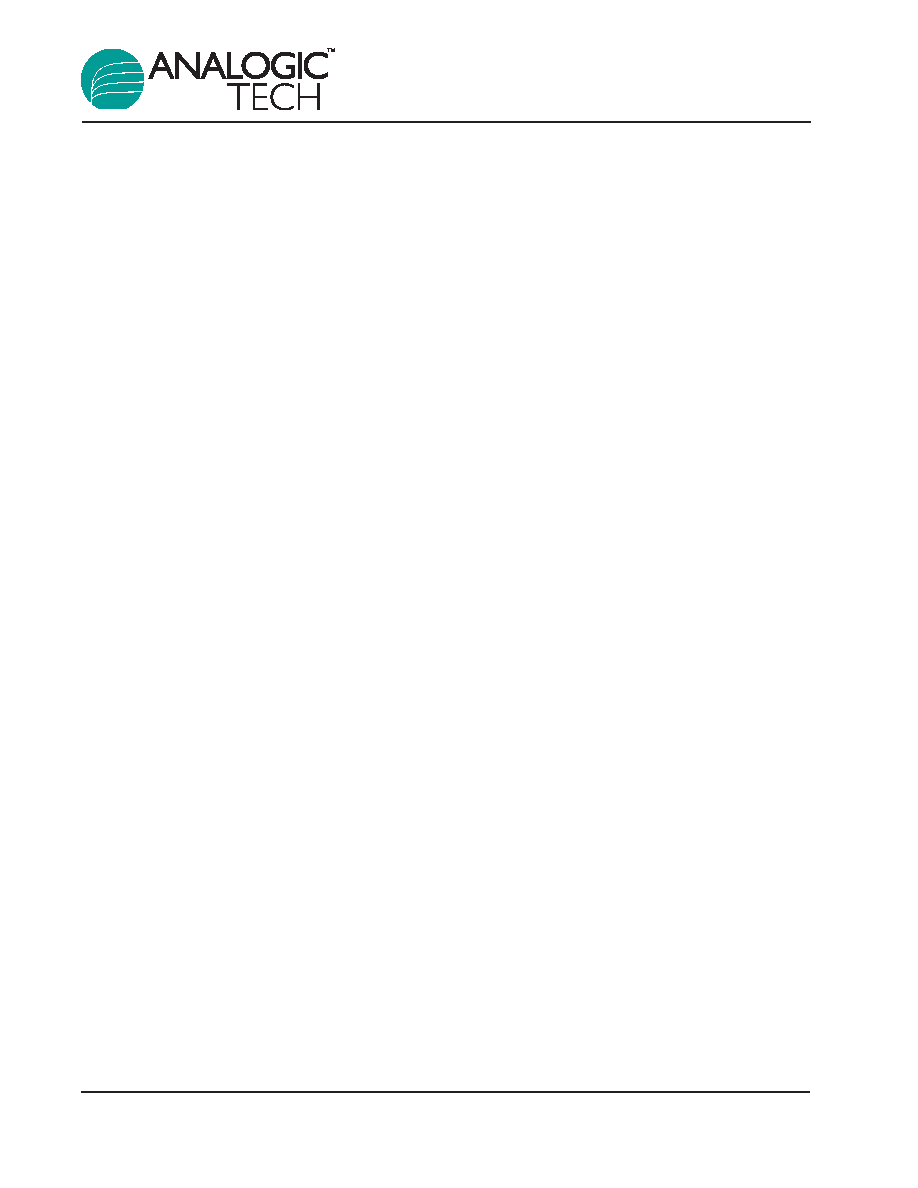
AAT3686
USB Port/AC Adapter
Lithium-Ion/Polymer Battery Charger
20
3686.2006.04.1.4
Example:
For an application where the fast charge current for
the adapter mode is set to 1A, V
ADP
= 5.0V, and the
worst case battery voltage is 3.0V, what is the max-
imum ambient temperature where the thermal lim-
iting will become active?
Given:
V
ADP
= 5.0V
V
BAT
= 3.0V
I
CC
= 1A
I
OP
= 0.75mA
T
J
= 110∞C
JA
= 37∞C/W
Using Equation 3, calculate the device power dissi-
pation for the stated condition:
Eq. 3:
The maximum ambient temperature before the
AAT3686 thermal loop becomes active can now be
calculated using Equation 4:
Eq. 4:
Therefore, under the stated conditions for this
worst case power dissipation example, the
AAT3686 will enter the thermal loop and lower the
fast charge constant current when the ambient
operating temperature rises above 35.86∞C.
Capacitor Selection
Input Capacitor
In general, it is good design practice to place a
decoupling capacitor between the V
ADP
and V
USB
pins and ground. An input capacitor in the range of
1µF to 22µF is recommended. If the source supply
is unregulated, it may be necessary to increase the
capacitance to keep the input voltage above the
under-voltage lockout threshold during device
enable and when battery charging is initiated.
If the AAT3686 adapter input is to be used in a sys-
tem with an external power supply source, such as
a typical AC-to-DC wall adapter, then a C
IN
capaci-
tor in the range of 10µF should be used. A larger
input capacitor in this application will minimize
switching or power bounce effects when the power
supply is "hot plugged." Likewise, a 10µF or greater
input capacitor is recommended for the USB input
to help buffer the effects of USB source power
switching, noise, and input cable impedance.
Output Capacitor
The AAT3686 only requires a 1µF ceramic capaci-
tor on the BAT pin to maintain circuit stability. This
value should be increased to 10µF or more if the
battery connection is made any distance from the
charger output. If the AAT3686 is to be used in
applications where the battery can be removed
from the charger, such as in the case of desktop
charging cradles, an output capacitor greater than
10µF may be required to prevent the device from
cycling on and off when no battery is present.
Printed Circuit Board Layout
Considerations
For the best results, it is recommended to physical-
ly place the battery pack as close to the AAT3686
BAT pin as possible. To minimize voltage drops on
the PCB, keep the high current carrying traces ade-
quately wide. For maximum power dissipation of the
AAT3686 TDFN package, the metal substrate
should be solder bonded to the board. It is also rec-
ommended to maximize the substrate contact to the
PCB ground plane layer to further increase local
heat dissipation. Refer to the AAT3686 evaluation
board for a good layout example.
T
A
= 110
∞C - (37∞C/W ∑ 2.00375W) = 35.86∞C
= 35.86
∞C
P
D
= (5.0V - 3.0V)(1A) + (5.0V ∑ 0.75mA)
= 2.00375W

AAT3686
USB Port/AC Adapter
Lithium-Ion/Polymer Battery Charger
3686.2006.04.1.4
21
AAT3686 Evaluation Board Schematic Diagram
Figure 5: AAT3686 Evaluation
Figure 6: AAT3686 Evaluation
Figure 7: AAT3686 Evaluation
Board Component Side Layout.
Board Solder Side Layout.
Board Assembly Layout.
Figure 8: AAT3686 Evaluation Board Schematic Diagram.
GND
USB
1
BAT
2
ADP
3
CHR
5
EN
6
ADPP#
7
TS
8
4
12
DATA
9
STAT2
10
STAT1
11
CT
USBSEL
13
USBL
14
USBH
15
ADPSET
16
AAT3686
U1
D2
D1
RED
LED
RED
LED
GREEN
LED
D3
40.2K
R5
8.06K
R3
4.99K
R7
4.99K
R8
1K
R10
Open
Open
Open
R6
10K
R1
4.99K
R9
R11
R12
8.06K
R4
10
F
C1
10
F
C2
10
F
C3
0.1
F
C5
Open
(Optional)
C6
1
2
3
USBSEL
J2
SW1
LO
HI
BAV74LT1
D4 (b)
BAV74LT1
D4 (a)
BAT
ADP
USB
DATA
CT
TS
1
2
3
ON/OFF
J1
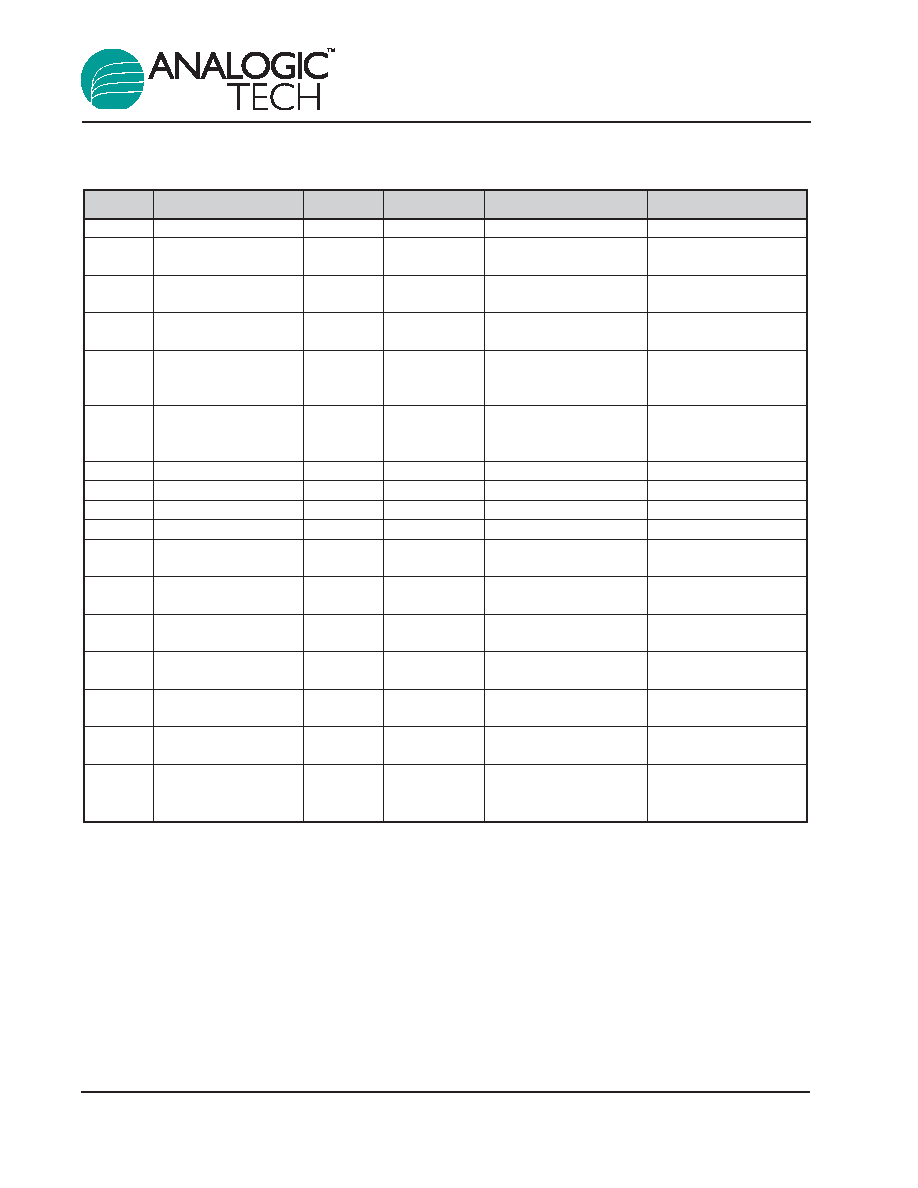
AAT3686
USB Port/AC Adapter
Lithium-Ion/Polymer Battery Charger
22
3686.2006.04.1.4
AAT3686 Evaluation Board Bill of Materials (BOM)
Quantity Description
Desig.
Footprint
Manufacturer
Part #
2
Test Pin
TS, CT
Mill-Max
6821-0-0001-00-00-08-0
2
Conn Term Block
USB, GND/
TBLOK2
Phoenix Contact
277-1274-ND
2.54mm 2POS
ADP, GND
1
Conn Term Block
BAT, TS,
TBLOK3
Phoenix Contact
277-1273-ND
2.54mm 3POS
GND
1
USB 2.0 Receptacle,
USB
USB-MINI-B
Hirose Electronic Co.,
H2959CT-ND
5POS
Ltd.
3
Capacitor, Ceramic,
C1, 2, 3
0805
Murata
490-1717-1-ND
10µF 6.3V 10% X5R
0805
1
Capacitor, Ceramic,
C5
0603
Murata
478-1244-2-ND
0.1µF 25V 10% X5R
0603
2
Typical Red LED
D1, D3
1206LED
Chicago Miniature Lamp CMD15-21SRC/TR8
1
Typical Green LED
D2
1206LED
Chicago Miniature Lamp CMD15-21SRC/TR8
1
Switching Diode
D4 a, b
SOT23-3
On Semi
BAV74LT1
2
Header, 3-Pin
J1, 2
Header 2mm-3 Sullins
6821-0-0001-00-00-08-0
1
RES 10k
1/16W R1
0603
Panasonic/ECG
P10KJTR-ND
5% 0603 SMD
1
RES 8.06k
1/16W R3,
4
0603
Panasonic/ECG
P9.76KHCT-ND
1% 0603 SMD
1
RES 40.2k
1/16W R5
0603
Panasonic/ECG
P40.2KHTR-ND
1% 0603 SMD
3
RES 4.99k
1/16W
R7, 8, 9
0603
Panasonic/ECG
P4.99KHTR-ND
1% 0603 SMD
1
RES 1.0k
1/16W R10
0603
Panasonic/ECG
P1.0KCGCT-ND
5% 0603 SMD
1
Switch Tact 6mm
SW1
Switch
ITT Industries/C&K Div
CKN9012-ND
SPST H = 5.0mm
1
AAT3686 USB Port/AC
U1
TDFN44-16
AnalogicTech
AAT3686IXN-4.2
Adapter Lithium-Ion/
Polymer Battery Charger

AAT3686
USB Port/AC Adapter
Lithium-Ion/Polymer Battery Charger
3686.2006.04.1.4
23
Ordering Information
Package Information
TDFN44-16
All dimensions in millimeters.
Index Area
(D/2 x E/2)
Detail "A"
Detail "B"
Top View
Bottom View
Detail "A"
Side View
Option A:
C0.30 (4x) max
Chamfered corner
Option B:
R0.30 (4x) max
Round corner
Detail "B"
0.16
Pin 1 Indicator
(optional)
0.1 REF
4.00 ± 0.05
2.60 ± 0.05
4.00
±
0.05
3.30
±
0.05
0.8
+
0.05 -0.20
0.05 ± 0.05
0.229
±
0.051
7.5∞ ± 7.5∞
0.375 ± 0.125
0.3 ± 0.10
0.45
±
0.05
0.23
±
0.05
0.075 ± 0.075
All AnalogicTech products are offered in Pb-free packaging. The term "Pb-free" means
semiconductor products that are in compliance with current RoHS standards, including
the requirement that lead not exceed 0.1% by weight in homogeneous materials. For more
information, please visit our website at http://www.analogictech.com/pbfree.
Package
Marking
1
Part Number (Tape and Reel)
2
TDFN44-16
PHXYY
AAT3686IXN-4.2-T1
1. XYY = assembly and date code.
2. Sample stock is generally held on part numbers listed in BOLD.
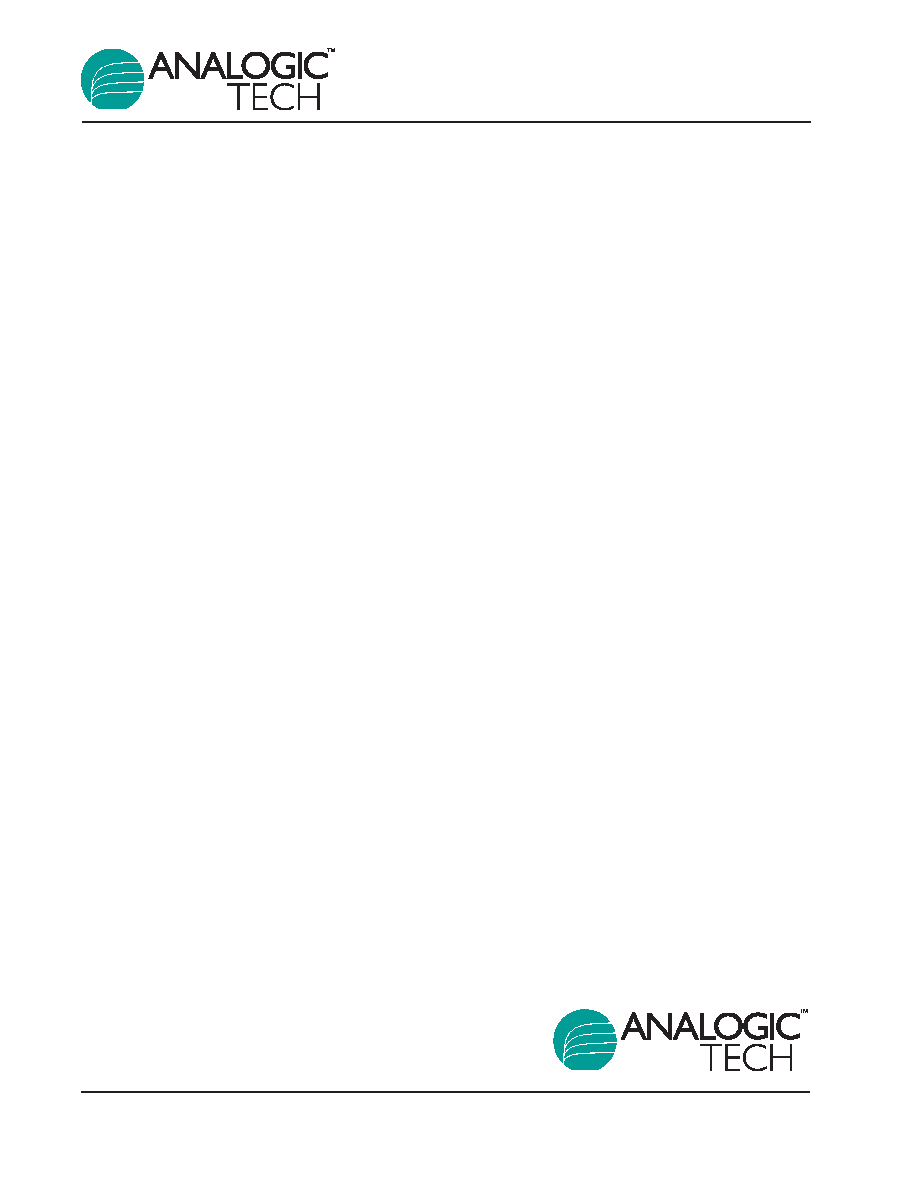
AAT3686
USB Port/AC Adapter
Lithium-Ion/Polymer Battery Charger
24
3686.2006.04.1.4
Advanced Analogic Technologies, Inc.
830 E. Arques Avenue, Sunnyvale, CA 94085
Phone (408) 737-4600
Fax (408) 737-4611
© Advanced Analogic Technologies, Inc.
AnalogicTech cannot assume responsibility for use of any circuitry other than circuitry entirely embodied in an AnalogicTech product. No circuit patent licenses, copyrights, mask work rights,
or other intellectual property rights are implied. AnalogicTech reserves the right to make changes to their products or specifications or to discontinue any product or service without notice.
Customers are advised to obtain the latest version of relevant information to verify, before placing orders, that information being relied on is current and complete. All products are sold sub-
ject to the terms and conditions of sale supplied at the time of order acknowledgement, including those pertaining to warranty, patent infringement, and limitation of liability. AnalogicTech
warrants performance of its semiconductor products to the specifications applicable at the time of sale in accordance with AnalogicTech's standard warranty. Testing and other quality con-
trol techniques are utilized to the extent AnalogicTech deems necessary to support this warranty. Specific testing of all parameters of each device is not necessarily performed.
AnalogicTech and the AnalogicTech logo are trademarks of Advanced Analogic Technologies Incorporated. All other brand and product names appearing in this document are regis-
tered trademarks or trademarks of their respective holders.























